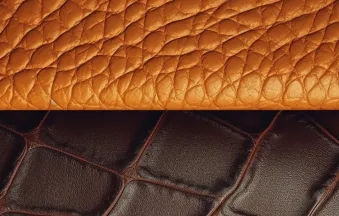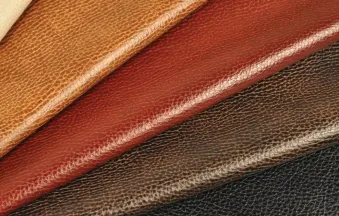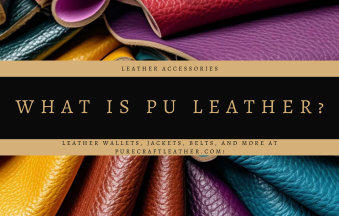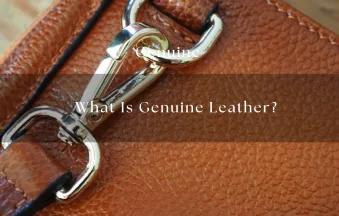Faux Real vs. Bonded Leather: Key Differences and Best Uses In 2025
Faux Real vs. Bonded Leather: Faux leather and bonded leather are two common types of synthetic leathers that are often confused with each other. Although they both serve as alternatives to genuine leather, they have different manufacturing processes, base materials, and performance characteristics.
Faux leather, also known as PU leather or artificial leather, is typically made by applying a polyurethane coating to a fabric backing, resulting in a smooth and uniform finish. It is known for being affordable, durable, and easy to clean.
On the other hand, bonded leather is made by blending leather scraps with adhesives and bonding the mixture to a fiber sheet, then coating it with a layer that mimics the look of real leather. While it may contain actual leather fibers, it’s generally less durable and may peel or crack over time with heavy use.
Understanding the differences in appearance, durability, and cost between these two materials can help you choose the right option for your needs—whether it’s for furniture, fashion accessories, or upholstery.
Table of Contents
ToggleWhat is Faux Leather?
In the discussion of Faux Real vs. Bonded Leather, faux leather—also known as vegan leather or synthetic leather—is a material designed to mimic the appearance and texture of real leather without using any animal products. It’s made primarily from plastic-based materials such as polyurethane (PU) or polyvinyl chloride (PVC).
Faux leather is widely used in furniture, clothing, bags, and automotive upholstery as a more affordable, cruelty-free, and low-maintenance alternative to genuine leather. It offers a stylish and practical solution for consumers seeking animal-free materials without sacrificing on look or functionality.
Manufacturing Process
In the discussion of Faux Real vs. Bonded Leather, it’s important to understand how faux leather is made. The process of making faux leather involves creating a synthetic fabric base that is coated with a plastic material to replicate the texture and finish of genuine leather.
There are two main types of faux leather:
PVC-based faux leather – Made using polyvinyl chloride (PVC), this type is durable and water-resistant, making it suitable for furniture and automotive upholstery. However, it’s often criticized for being less breathable and less environmentally friendly.
PU-based faux leather – Uses polyurethane (PU), which is considered a eco-friendlier and more flexible alternative to PVC. It has a softer, more natural feel, and is generally more breathable, making it a preferred choice for fashion and clothing.
Key Characteristics of Faux Leather:
In the comparison of Faux Real vs. Bonded Leather, it’s essential to consider the key advantages and limitations of faux leather:
Cruelty-Free: Faux leather does not use any animal products, making it a popular choice among vegan consumers and those seeking ethical fashion alternatives.
Affordable: Faux leather is generally less expensive than genuine leather, making it a cost-effective option for many buyers.
Maintenance: It is easy to clean and maintain. A simple wipe-down is often enough to keep synthetic leather looking new and fresh.
Durability: While faux leather can be fairly durable, it may wear down over time, especially when exposed to heat or friction. It can crack or peel, particularly if the material quality is low.
What is Bonded Leather?
In the comparison of Faux Real vs. Bonded Leather, bonded leather stands out as a blend of genuine leather and synthetic materials. It’s made by shredding leftover scraps of real leather and then bonding them together using adhesives. This mixture is pressed into sheets and coated with a layer of polyurethane (PU) or polyvinyl chloride (PVC) to give it a smooth, leather-like finish.
The purpose of bonded leather is to offer a material that replicates the feel of authentic leather while benefiting from the cost-effectiveness and versatility of synthetic leather. It is commonly used in furniture, office chairs, and budget-friendly accessories, providing a middle ground between faux leather and genuine leather.
Manufacturing Process
In the context of Faux Real vs. Bonded Leather, it’s important to understand how bonded leather is made. The production of bonded leather involves the processing of real leather scraps or fibers, which are typically left over from the tanning and manufacturing of genuine leather products.
These leather remnants are ground into small particles, mixed with a binding agent such as polyurethane (PU), and then reformed into sheets of material. To enhance its durability and visual appeal, the final product is coated with a layer of synthetic resin, giving it a finish similar to that of natural leather.
This blend of recycled leather and synthetic materials creates an affordable alternative, contributing to the ongoing comparison of Faux Real vs. Bonded Leather in today’s leather alternatives market.
Key Characteristics of Bonded Leather:
Composition: It contains real leather (usually at least 50% leather content), which can give it a more authentic feel compared to faux leather or other synthetic leather alternatives.
Durability: Bonded leather is often more durable than faux leather, but it can still experience cracking and peeling over time. Due to the bonding process, it is weaker than full-grain or top-grain leather, and more prone to wear and tear than high-quality vegan leather.
Eco-Friendly: Since bonded leather uses leftover leather scraps from the leather industry, it can be viewed as a more environmentally friendly option in certain cases, helping to reduce waste.
Appearance: Bonded leather tends to have a more uniform appearance, though it may lack the natural texture, grain, and patina of genuine leather. Its synthetic coating can sometimes result in a more artificial look and feel.
Faux Leather vs. Bonded Leather: Key Differences
- Material Composition:
- Faux leather is entirely synthetic and does not contain any animal products.
- Bonded leather contains a significant amount of real leather, typically ranging from 50% to 70%, with the remainder being synthetic material.
- Durability:
- Faux leather can last a long time with proper care, but it is more prone to wear, such as cracking or peeling, especially at lower quality levels.
- Bonded leather is generally more durable than faux leather but may suffer from cracking and wear over time, especially where the leather content is low.
- Environmental Impact:
- Faux leather has a smaller environmental footprint in terms of the use of animal products, but the production of PVC-based faux leather can result in more pollution and waste.
- Bonded leather helps reduce leather waste by using scraps, but the adhesives and synthetic materials used in the bonding process may contribute to environmental concerns.
- Cost:
- Faux leather tends to be cheaper than bonded leather, as it does not require the use of any real leather, which can be costly.
- Bonded leather is often slightly more expensive than faux leather due to the inclusion of real leather content.
- Appearance and Feel:
- Faux leather can be made to resemble real leather, but it often feels less natural and may have a more plastic-like texture.
- Bonded leather can feel closer to real leather, though it may lack the depth, patina, and character of solid leather.
Uses Of Faux And Bonded Leather
When to Use Faux Leather
- If you are looking for a cruelty-free, budget-friendly option for upholstery, clothing, or accessories.
- If you want a material that is easy to clean and maintain, faux leather is resistant to stains and liquids.
- Ideal for short-term use or for items that don’t require the durability of genuine leather.
When to Use Bonded Leather
- When you need a more durable material with the texture of leather but at a lower cost than solid leather.
- Great for furniture, bookbinding, or other decorative uses where an authentic leather look is desired, but budget or ethical considerations are in play.
- Suitable for more sustainable applications, as it uses leftover leather scraps, helping to reduce waste.
Final Words
In conclusion, the choice in the debate of Faux Real vs. Bonded Leather depends on the specific needs of your project. Faux leather is ideal if you’re looking for a vegan, affordable, and easy-to-care-for alternative to real leather. It’s especially suited for those who prioritize cruelty-free materials and low maintenance.
On the other hand, bonded leather offers a compromise, combining the look and feel of genuine leather with a lower price point. However, it is more susceptible to wear, including peeling and cracking, over time.
Both synthetic leather options have their strengths and weaknesses, so understanding their differences in durability, appearance, and cost can help you choose the best material for your specific use—whether in furniture, fashion, or automotive interiors.

















